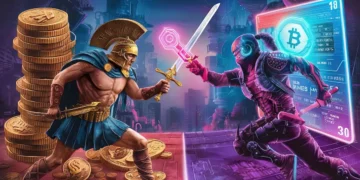NFTs (non-fungible tokens) have taken the art and collectibles world by storm, with some selling for millions of dollars. For example, a single CryptoPunk NFT sold for $23 million in 2021. Such high price tags put these digital assets out of reach for most collectors. NFT fractionalization is a solution that allows multiple people to share ownership of a high-value NFT by splitting it into smaller fractions.
This guide explains what fractionalized NFTs are, why they’re useful, how to fractionalize an NFT step-by-step, the top fractional ownership platforms, pros and cons, and best practices for investing in fractional NFTs.
What Is NFT Fractionalization (and Why Is It Useful)?
NFT fractionalization is the process of dividing one NFT into many fungible tokens (usually ERC-20 tokens) that each represent a percentage stake in the original, indivisible NFT In practical terms, the original NFT is locked in a smart contract “vault,” and fungible tokens are minted to represent shares of that NFT. Each token acts like a digital IOU indicating you own X% of that NFT.
Fractionalizing an NFT makes owning high-value NFTs more accessible. Instead of needing hundreds of thousands of dollars to buy a Bored Ape or Rare Pepe, a collector can buy a fraction for a much smaller amount. This lower barrier to entry allows a wider range of investors to participate in blue-chip NFT collections.
Fractionalization also improves liquidity in the NFT market – owners don’t have to find a single buyer for a $1M NFT; they can sell fractional tokens to many buyers, making it faster and easier to raise money.
For investors, fractions are easier to trade on secondary markets, providing an easier exit strategy than selling a whole NFT which might take weeks or months.
Another benefit is price discovery. When many people buy and sell fractions of an NFT, it helps determine the NFT’s market value more accurately through collective bidding.
Fractional ownership can even foster community engagement – multiple collectors co-owning an NFT can form communities or DAOs around shared assets and even vote on the asset’s future (for instance, whether to accept a buyout offer).
In short, fractionalization democratizes NFT investing. Even iconic NFTs have been fractionalized to open up ownership: for example, the original Doge meme NFT was broken into 17 billion tokens called $DOG, allowing thousands of fans to own a piece of it.
How to Fractionalize an NFT: Step-by-Step Guide
If you own a high-value NFT and want to fractionalize it, follow these general steps:
Choose the NFT to Fractionalize: Decide which NFT in your collection you want to split into fractions. It could be a valuable digital artwork, collectible, virtual land, etc. Ensure you truly own the NFT in a wallet you control.
Select a Fractionalization Platform: Use a platform or protocol that supports NFT fractionalization. These platforms provide the smart contract infrastructure to split NFTs into ERC-20 tokens.
Lock the NFT in a Smart Contract: Initiate the fractionalization process on the chosen platform. This usually involves locking your NFT into a secure smart contract or vault. The platform will deploy a smart contract that holds your NFT and defines the terms of fractional ownership. For example, you might specify the total number of fraction tokens to create (representing 100% of the NFT) and an optional reserve price or buyout price.
Mint Fractional Tokens: Once the NFT is locked, the platform mints the fractional tokens (often ERC-20 tokens) according to your specified supply. Each token represents a share of the underlying NFT (e.g. owning 1% of the NFT). These tokens are fungible, meaning all fractions are interchangeable and can be traded easily.
Distribute or Sell the Fractions: After minting, you can distribute the fractional tokens. Some owners keep a portion and sell the rest to the public via the platform’s marketplace or a decentralized exchange. Investors can now buy these tokens to gain partial ownership of the NFT. Typically, the platform will list your fractionalized NFT project so that other collectors can purchase fractions in exchange for cryptocurrency.
Manage Ownership and Governance: Once fractions are sold, you and other token holders collectively own the NFT. The smart contract keeps track of ownership and may enable certain governance features. For instance, fractional platforms often include a buyout mechanism: someone can bid to purchase the entire NFT by buying out all fraction owners at a premium.
Fraction holders might vote on whether to accept a buyout offer, and if it passes, the NFT is released to the buyer and fraction holders are paid out proportionally. As a fraction owner, you may also have voting rights on decisions like setting a reserve price or deciding not to entertain buyout bids
Every platform’s process will have its own details, but the above steps capture the general flow. Always follow the specific instructions of the platform you use, and be sure to understand any fees or terms (like curator fees or lock-up periods) before fractionalizing your NFT.

Pros and Cons of Fractionalized NFTs
Before diving into fractional NFT investing or fractionalizing your own NFT, it’s important to weigh the benefits against the drawbacks. Here are the main pros and cons for collectors and investors:
Pros (Benefits) of Fractional NFTs
Accessibility for Investors: High-value NFTs can be out of reach for most buyers. Fractionalization lowers the cost of entry, allowing collectors with modest budgets to own shares of a CryptoPunk or Bored Ape instead of being completely priced out. This opens up blue-chip NFT investing to a broader audience, democratizing the market
Increased Liquidity: Selling a $500,000 NFT can be difficult, but selling 1000 shares of it at $500 each might attract buyers much faster. Fractional NFTs improve liquidity by making it easier for owners to sell portions of an asset and for investors to trade those shares on secondary markets. Investors can exit their position by selling fractions without needing the entire NFT to change hands.
Portfolio Diversification: Instead of tying up a huge sum in one NFT, an investor can spread the same money across fractions of multiple NFTs. This way, you can build a diversified NFT portfolio (e.g., 1% of several different artworks) and spread risk across various projects. Diversification can be a smart strategy in the volatile NFT market.
Price Discovery and Fair Valuation: Fractional ownership creates many data points for sales, which helps in discovering a fair market price for the underlying NFT. With more people trading fractions at different valuations, it becomes clearer what the entire NFT might be worth. This can benefit the original owner by potentially revealing a higher collective value, and it benefits buyers by providing transparency.
Community & Shared Ownership Experience: Fractions of an NFT can cultivate communities of co-owners who share a passion for the asset. This community engagement can add intangible value – for example, fractional owners might form a DAO to collectively decide on the NFT’s use or to co-own more NFTs. It also allows artists and creators to have a wider base of supporters if they choose to sell their work fractionally, potentially increasing engagement with their art.
Cons (Drawbacks) of Fractional NFTs
Lack of Utility/Perks for Fraction Owners: When you own a fraction of an NFT, you typically do not get the full benefits that come with owning the whole NFT. Many NFT collections offer perks to full owners (like exclusive airdrops, event access, or IP rights), and fractional owners “probably won’t have access to any of the perks” reserved for full NFT holders. In essence, you have financial exposure to the asset’s value, but not the utility or bragging rights of full ownership.
Buyout Risk and Loss of Ownership: Fractionalization introduces a scenario where someone could buy out the entire NFT from the fraction owners, sometimes against their wishes. If a buyer initiates an auction and meets the conditions to purchase the whole NFT (often by paying a premium), you could be forced to sell your fraction for a price set by that auction.
While you would get compensated, you might have preferred to hold longer. These undesirable buyouts are a risk for original owners and fraction investors, since a deep-pocketed bidder can effectively end the fractional ownership arrangement.
Regulatory Uncertainty: Fractional NFTs blur the line between collectibles and securities. The SEC has noted that fractionalized assets could be considered investment contracts (securities) and may require compliance with securities laws. In jurisdictions like the U.S., this is a gray area – regulators have warned creators to be careful not to create unregistered securities.
The lack of clear regulation means legal risks for platforms and possibly investors. Future regulations could impact how (or if) fractional NFTs are offered to the public. Investors should be aware that fractional NFT tokens might not have the same investor protections as regulated securities.
Smart Contract and Security Risks: The whole fractional model hinges on smart contracts – if the contract holding the NFT or governing the fractions has a bug or gets hacked, your investment is at risk. Smart contract vulnerabilities have led to multi-million dollar hacks in DeFi before, and fractional NFTs carry the same technical risk.
A poorly written contract could be exploited to steal the underlying NFT or the value of the fraction tokens. It’s crucial that the fractionalization platform’s contracts are audited and secure, but even then, bugs can surface.
Market Volatility and Low Liquidity Risk: While fractionalization can improve liquidity, it doesn’t guarantee it. Some fractional tokens may end up thinly traded – you might own a fraction that no one wants to buy from you, especially if interest in that NFT wanes. Additionally, fractional NFTs can be highly volatile.
As liquid ERC-20 tokens, their prices can swing rapidly with market sentiment, sometimes even more wildly than the NFT itself. If the crypto market drops or the underlying NFT loses hype, fraction prices could plunge quickly. Investors must be prepared for the possibility of large price fluctuations and low liquidity in the fractional token markets.
Complexity and Ownership Coordination: Owning fractions adds complexity to what was a simple concept of one owner per NFT. Decisions about the NFT now require coordination or voting among many token holders, which can lead to conflicts. For example, if there’s an offer to buy the NFT, some fraction owners might want to sell while others don’t. Disagreements or lack of consensus could create tension and uncertainty.
Moreover, an NFT generally “makes sense” to own whole – partial ownership is only an investment, not a usable collectible. If you ever want to fully own the NFT, you’d have to buy out all other fractions, which could be impractical or expensive. Despite these cons, many collectors find the benefits outweigh the risks as long as they approach fractional NFTs carefully. Next, we’ll cover best practices to safely navigate fractional NFT investing.

Best Practices for Investing in Fractionalized NFTs
If you’re considering buying fractional NFTs or fractionalizing your own, keep these tips and considerations in mind to make informed decisions:
Do Your Homework on the NFT: Thoroughly research the underlying NFT before investing in a fraction. Evaluate its intrinsic value – factors like the artist/creator, rarity, historical sales, and community interest. Also assess the broader market value. Investors should “conduct thorough due diligence, evaluating both the intrinsic and market value of the NFT” before buying fractions. Essentially, invest in fractional NFTs that you believe have strong fundamentals just as you would for whole NFTs.
Choose Reputable Platforms: Use established fractionalization platforms with a good track record. Check if the platform’s smart contracts have been audited for security. Be wary of new or unknown platforms offering fractional NFTs; as with any emerging tech, scams can exist. Ensure the platform clearly outlines how it secures the NFT vault and handles buyouts or other processes.
Understand the Terms (Buyout and Fees): Every fractional NFT will have certain terms coded in the smart contract. Understand the buyout mechanism for the fractions you own – is there a reserve price for the whole NFT? How can someone initiate a buyout auction, and do fraction holders get to vote on it?
Knowing this will prevent surprises where your fraction gets bought out unexpectedly. Also, check if there are any fees. Some platforms allow the original owner (curator) to take a fee or royalty annually. Understand how any curator fee or platform fee might affect your returns.
Be Aware of Regulatory Constraints: If you are in a country with strict securities laws (like the US), be mindful that fractional NFTs could be seen as securities by regulators. Some platforms might geo-block U.S. users or require accreditation. Keep an eye on legal developments and consider compliance – especially if you plan to fractionalize your own NFT (you don’t want to unintentionally run afoul of securities regulations). When in doubt, consult legal advice for high-value fractional offerings.
Monitor Market Liquidity: Before investing a large sum into a fractional token, check the trading volume and liquidity for that project. If only a handful of people are trading it, you might struggle to sell your fractions later. Prefer fractional NFTs that have an active community and trading market, which indicates you can enter and exit more freely. Illiquid fractions can trap your funds even if the theoretical value is high.
Diversify and Manage Risk: Treat fractional NFTs as a high-risk, speculative investment – because they are. Don’t put all your capital into one fractional NFT. It’s wise to spread your investment across different projects or only allocate a small portion of your portfolio to fractional NFTs. Diversification can help manage the volatility. And as always in crypto, never invest more than you can afford to lose.
Stay Vigilant of Influencer Hype: Just because a celebrity or influencer is backing a fractionalized collectible doesn’t guarantee its quality or future value. We’ve seen influencer-backed NFT projects fizzle out or turn out to be scams. Take celebrity endorsements with skepticism and focus on the underlying asset’s merits. The NFT community has cautioned that influencer involvement should be scrutinized carefully. Make sure the project has real substance beyond just hype.
Secure Your Fractional Tokens: Fractional NFT tokens are like any other crypto asset in your wallet. Keep them in a secure wallet and follow best security practices. Beware of phishing or malicious links related to the fractional project – as interest in fractional NFTs grows, so do scams targeting investors.
Never share your wallet’s private keys or seed phrase. If the fractions are valuable, consider using hardware wallets or trusted custody solutions for safety.
By following these best practices, you can enjoy the benefits of fractionalized NFTs while mitigating some of the risks. Fractional NFTs offer an exciting new way to invest in the NFT market by making high-value assets attainable and tradeable in pieces.
With a clear understanding of how they work and a cautious approach to investing, collectors and investors can leverage fractionalization to diversify their NFT portfolios and participate in the ownership of iconic digital assets.
Final Thoughts
Fractionalizing high-value NFTs is changing the landscape of NFT investing. It provides a win-win: owners gain liquidity and price discovery, while fans and investors gain access to assets that were once unobtainable. By using reputable fractionalization platforms and understanding the process, anyone can split an NFT into fractions and invite others to co-own it.
As discussed, fractionalized NFTs come with trade-offs – greater accessibility and liquidity versus added complexity and risk. For NFT collectors and investors, the key is to stay informed and proceed thoughtfully.
Whether you’re fractionally selling a rare NFT or buying a tiny slice of a digital grail, a well-researched, careful approach will help you make the most of this innovative trend in the NFT space. With the best practices outlined above, you’ll be well-equipped to navigate the world of fractional NFTs and possibly own a piece of the next multimillion-dollar digital masterpiece.
NFTs (non-fungible tokens) have taken the art and collectibles world by storm, with some selling for millions of dollars. For example, a single CryptoPunk NFT sold for $23 million in 2021. Such high price tags put these digital assets out of reach for most collectors. NFT fractionalization is a solution that allows multiple people to share ownership of a high-value NFT by splitting it into smaller fractions.
This guide explains what fractionalized NFTs are, why they’re useful, how to fractionalize an NFT step-by-step, the top fractional ownership platforms, pros and cons, and best practices for investing in fractional NFTs.
What Is NFT Fractionalization (and Why Is It Useful)?
NFT fractionalization is the process of dividing one NFT into many fungible tokens (usually ERC-20 tokens) that each represent a percentage stake in the original, indivisible NFT In practical terms, the original NFT is locked in a smart contract “vault,” and fungible tokens are minted to represent shares of that NFT. Each token acts like a digital IOU indicating you own X% of that NFT.
Fractionalizing an NFT makes owning high-value NFTs more accessible. Instead of needing hundreds of thousands of dollars to buy a Bored Ape or Rare Pepe, a collector can buy a fraction for a much smaller amount. This lower barrier to entry allows a wider range of investors to participate in blue-chip NFT collections.
Fractionalization also improves liquidity in the NFT market – owners don’t have to find a single buyer for a $1M NFT; they can sell fractional tokens to many buyers, making it faster and easier to raise money.
For investors, fractions are easier to trade on secondary markets, providing an easier exit strategy than selling a whole NFT which might take weeks or months.
Another benefit is price discovery. When many people buy and sell fractions of an NFT, it helps determine the NFT’s market value more accurately through collective bidding.
Fractional ownership can even foster community engagement – multiple collectors co-owning an NFT can form communities or DAOs around shared assets and even vote on the asset’s future (for instance, whether to accept a buyout offer).
In short, fractionalization democratizes NFT investing. Even iconic NFTs have been fractionalized to open up ownership: for example, the original Doge meme NFT was broken into 17 billion tokens called $DOG, allowing thousands of fans to own a piece of it.
How to Fractionalize an NFT: Step-by-Step Guide
If you own a high-value NFT and want to fractionalize it, follow these general steps:
Choose the NFT to Fractionalize: Decide which NFT in your collection you want to split into fractions. It could be a valuable digital artwork, collectible, virtual land, etc. Ensure you truly own the NFT in a wallet you control.
Select a Fractionalization Platform: Use a platform or protocol that supports NFT fractionalization. These platforms provide the smart contract infrastructure to split NFTs into ERC-20 tokens.
Lock the NFT in a Smart Contract: Initiate the fractionalization process on the chosen platform. This usually involves locking your NFT into a secure smart contract or vault. The platform will deploy a smart contract that holds your NFT and defines the terms of fractional ownership. For example, you might specify the total number of fraction tokens to create (representing 100% of the NFT) and an optional reserve price or buyout price.
Mint Fractional Tokens: Once the NFT is locked, the platform mints the fractional tokens (often ERC-20 tokens) according to your specified supply. Each token represents a share of the underlying NFT (e.g. owning 1% of the NFT). These tokens are fungible, meaning all fractions are interchangeable and can be traded easily.
Distribute or Sell the Fractions: After minting, you can distribute the fractional tokens. Some owners keep a portion and sell the rest to the public via the platform’s marketplace or a decentralized exchange. Investors can now buy these tokens to gain partial ownership of the NFT. Typically, the platform will list your fractionalized NFT project so that other collectors can purchase fractions in exchange for cryptocurrency.
Manage Ownership and Governance: Once fractions are sold, you and other token holders collectively own the NFT. The smart contract keeps track of ownership and may enable certain governance features. For instance, fractional platforms often include a buyout mechanism: someone can bid to purchase the entire NFT by buying out all fraction owners at a premium.
Fraction holders might vote on whether to accept a buyout offer, and if it passes, the NFT is released to the buyer and fraction holders are paid out proportionally. As a fraction owner, you may also have voting rights on decisions like setting a reserve price or deciding not to entertain buyout bids
Every platform’s process will have its own details, but the above steps capture the general flow. Always follow the specific instructions of the platform you use, and be sure to understand any fees or terms (like curator fees or lock-up periods) before fractionalizing your NFT.

Pros and Cons of Fractionalized NFTs
Before diving into fractional NFT investing or fractionalizing your own NFT, it’s important to weigh the benefits against the drawbacks. Here are the main pros and cons for collectors and investors:
Pros (Benefits) of Fractional NFTs
Accessibility for Investors: High-value NFTs can be out of reach for most buyers. Fractionalization lowers the cost of entry, allowing collectors with modest budgets to own shares of a CryptoPunk or Bored Ape instead of being completely priced out. This opens up blue-chip NFT investing to a broader audience, democratizing the market
Increased Liquidity: Selling a $500,000 NFT can be difficult, but selling 1000 shares of it at $500 each might attract buyers much faster. Fractional NFTs improve liquidity by making it easier for owners to sell portions of an asset and for investors to trade those shares on secondary markets. Investors can exit their position by selling fractions without needing the entire NFT to change hands.
Portfolio Diversification: Instead of tying up a huge sum in one NFT, an investor can spread the same money across fractions of multiple NFTs. This way, you can build a diversified NFT portfolio (e.g., 1% of several different artworks) and spread risk across various projects. Diversification can be a smart strategy in the volatile NFT market.
Price Discovery and Fair Valuation: Fractional ownership creates many data points for sales, which helps in discovering a fair market price for the underlying NFT. With more people trading fractions at different valuations, it becomes clearer what the entire NFT might be worth. This can benefit the original owner by potentially revealing a higher collective value, and it benefits buyers by providing transparency.
Community & Shared Ownership Experience: Fractions of an NFT can cultivate communities of co-owners who share a passion for the asset. This community engagement can add intangible value – for example, fractional owners might form a DAO to collectively decide on the NFT’s use or to co-own more NFTs. It also allows artists and creators to have a wider base of supporters if they choose to sell their work fractionally, potentially increasing engagement with their art.
Cons (Drawbacks) of Fractional NFTs
Lack of Utility/Perks for Fraction Owners: When you own a fraction of an NFT, you typically do not get the full benefits that come with owning the whole NFT. Many NFT collections offer perks to full owners (like exclusive airdrops, event access, or IP rights), and fractional owners “probably won’t have access to any of the perks” reserved for full NFT holders. In essence, you have financial exposure to the asset’s value, but not the utility or bragging rights of full ownership.
Buyout Risk and Loss of Ownership: Fractionalization introduces a scenario where someone could buy out the entire NFT from the fraction owners, sometimes against their wishes. If a buyer initiates an auction and meets the conditions to purchase the whole NFT (often by paying a premium), you could be forced to sell your fraction for a price set by that auction.
While you would get compensated, you might have preferred to hold longer. These undesirable buyouts are a risk for original owners and fraction investors, since a deep-pocketed bidder can effectively end the fractional ownership arrangement.
Regulatory Uncertainty: Fractional NFTs blur the line between collectibles and securities. The SEC has noted that fractionalized assets could be considered investment contracts (securities) and may require compliance with securities laws. In jurisdictions like the U.S., this is a gray area – regulators have warned creators to be careful not to create unregistered securities.
The lack of clear regulation means legal risks for platforms and possibly investors. Future regulations could impact how (or if) fractional NFTs are offered to the public. Investors should be aware that fractional NFT tokens might not have the same investor protections as regulated securities.
Smart Contract and Security Risks: The whole fractional model hinges on smart contracts – if the contract holding the NFT or governing the fractions has a bug or gets hacked, your investment is at risk. Smart contract vulnerabilities have led to multi-million dollar hacks in DeFi before, and fractional NFTs carry the same technical risk.
A poorly written contract could be exploited to steal the underlying NFT or the value of the fraction tokens. It’s crucial that the fractionalization platform’s contracts are audited and secure, but even then, bugs can surface.
Market Volatility and Low Liquidity Risk: While fractionalization can improve liquidity, it doesn’t guarantee it. Some fractional tokens may end up thinly traded – you might own a fraction that no one wants to buy from you, especially if interest in that NFT wanes. Additionally, fractional NFTs can be highly volatile.
As liquid ERC-20 tokens, their prices can swing rapidly with market sentiment, sometimes even more wildly than the NFT itself. If the crypto market drops or the underlying NFT loses hype, fraction prices could plunge quickly. Investors must be prepared for the possibility of large price fluctuations and low liquidity in the fractional token markets.
Complexity and Ownership Coordination: Owning fractions adds complexity to what was a simple concept of one owner per NFT. Decisions about the NFT now require coordination or voting among many token holders, which can lead to conflicts. For example, if there’s an offer to buy the NFT, some fraction owners might want to sell while others don’t. Disagreements or lack of consensus could create tension and uncertainty.
Moreover, an NFT generally “makes sense” to own whole – partial ownership is only an investment, not a usable collectible. If you ever want to fully own the NFT, you’d have to buy out all other fractions, which could be impractical or expensive. Despite these cons, many collectors find the benefits outweigh the risks as long as they approach fractional NFTs carefully. Next, we’ll cover best practices to safely navigate fractional NFT investing.

Best Practices for Investing in Fractionalized NFTs
If you’re considering buying fractional NFTs or fractionalizing your own, keep these tips and considerations in mind to make informed decisions:
Do Your Homework on the NFT: Thoroughly research the underlying NFT before investing in a fraction. Evaluate its intrinsic value – factors like the artist/creator, rarity, historical sales, and community interest. Also assess the broader market value. Investors should “conduct thorough due diligence, evaluating both the intrinsic and market value of the NFT” before buying fractions. Essentially, invest in fractional NFTs that you believe have strong fundamentals just as you would for whole NFTs.
Choose Reputable Platforms: Use established fractionalization platforms with a good track record. Check if the platform’s smart contracts have been audited for security. Be wary of new or unknown platforms offering fractional NFTs; as with any emerging tech, scams can exist. Ensure the platform clearly outlines how it secures the NFT vault and handles buyouts or other processes.
Understand the Terms (Buyout and Fees): Every fractional NFT will have certain terms coded in the smart contract. Understand the buyout mechanism for the fractions you own – is there a reserve price for the whole NFT? How can someone initiate a buyout auction, and do fraction holders get to vote on it?
Knowing this will prevent surprises where your fraction gets bought out unexpectedly. Also, check if there are any fees. Some platforms allow the original owner (curator) to take a fee or royalty annually. Understand how any curator fee or platform fee might affect your returns.
Be Aware of Regulatory Constraints: If you are in a country with strict securities laws (like the US), be mindful that fractional NFTs could be seen as securities by regulators. Some platforms might geo-block U.S. users or require accreditation. Keep an eye on legal developments and consider compliance – especially if you plan to fractionalize your own NFT (you don’t want to unintentionally run afoul of securities regulations). When in doubt, consult legal advice for high-value fractional offerings.
Monitor Market Liquidity: Before investing a large sum into a fractional token, check the trading volume and liquidity for that project. If only a handful of people are trading it, you might struggle to sell your fractions later. Prefer fractional NFTs that have an active community and trading market, which indicates you can enter and exit more freely. Illiquid fractions can trap your funds even if the theoretical value is high.
Diversify and Manage Risk: Treat fractional NFTs as a high-risk, speculative investment – because they are. Don’t put all your capital into one fractional NFT. It’s wise to spread your investment across different projects or only allocate a small portion of your portfolio to fractional NFTs. Diversification can help manage the volatility. And as always in crypto, never invest more than you can afford to lose.
Stay Vigilant of Influencer Hype: Just because a celebrity or influencer is backing a fractionalized collectible doesn’t guarantee its quality or future value. We’ve seen influencer-backed NFT projects fizzle out or turn out to be scams. Take celebrity endorsements with skepticism and focus on the underlying asset’s merits. The NFT community has cautioned that influencer involvement should be scrutinized carefully. Make sure the project has real substance beyond just hype.
Secure Your Fractional Tokens: Fractional NFT tokens are like any other crypto asset in your wallet. Keep them in a secure wallet and follow best security practices. Beware of phishing or malicious links related to the fractional project – as interest in fractional NFTs grows, so do scams targeting investors.
Never share your wallet’s private keys or seed phrase. If the fractions are valuable, consider using hardware wallets or trusted custody solutions for safety.
By following these best practices, you can enjoy the benefits of fractionalized NFTs while mitigating some of the risks. Fractional NFTs offer an exciting new way to invest in the NFT market by making high-value assets attainable and tradeable in pieces.
With a clear understanding of how they work and a cautious approach to investing, collectors and investors can leverage fractionalization to diversify their NFT portfolios and participate in the ownership of iconic digital assets.
Final Thoughts
Fractionalizing high-value NFTs is changing the landscape of NFT investing. It provides a win-win: owners gain liquidity and price discovery, while fans and investors gain access to assets that were once unobtainable. By using reputable fractionalization platforms and understanding the process, anyone can split an NFT into fractions and invite others to co-own it.
As discussed, fractionalized NFTs come with trade-offs – greater accessibility and liquidity versus added complexity and risk. For NFT collectors and investors, the key is to stay informed and proceed thoughtfully.
Whether you’re fractionally selling a rare NFT or buying a tiny slice of a digital grail, a well-researched, careful approach will help you make the most of this innovative trend in the NFT space. With the best practices outlined above, you’ll be well-equipped to navigate the world of fractional NFTs and possibly own a piece of the next multimillion-dollar digital masterpiece.





















































































clomiphene generic where can i get clomiphene without dr prescription where can i buy generic clomid clomiphene sale generic clomiphene price get cheap clomid pills where can i get cheap clomiphene tablets
This is the make of enter I unearth helpful.
Thanks on sharing. It’s top quality.
how to get zithromax without a prescription – order ciplox 500mg sale flagyl 200mg price
rybelsus oral – generic periactin 4 mg cyproheptadine order online
order domperidone 10mg without prescription – sumycin drug buy flexeril pills
zithromax 250mg drug – nebivolol 5mg oral order bystolic 5mg pill
buy amoxiclav without prescription – https://atbioinfo.com/ cost acillin
esomeprazole 40mg pill – anexa mate buy nexium 20mg online
order generic medex – blood thinner hyzaar for sale online
purchase mobic generic – swelling order mobic 15mg
order generic deltasone 20mg – corticosteroid buy prednisone cheap
online ed pills – site hims ed pills
amoxicillin generic – amoxil pills order generic amoxicillin
fluconazole 200mg for sale – flucoan purchase diflucan sale
buy generic cenforce 100mg – https://cenforcers.com/# purchase cenforce
zantac sale – https://aranitidine.com/# order generic zantac 300mg
when does tadalafil go generic – strong tadafl generic cialis tadalafil 20mg reviews
This is the amicable of topic I have reading. efectos de accutane
buy viagra sweden – strong vpls viagra sale online uk
I couldn’t hold back commenting. Warmly written! https://buyfastonl.com/
With thanks. Loads of expertise! https://ursxdol.com/get-cialis-professional/
More content pieces like this would create the интернет better. https://prohnrg.com/
Thanks for putting this up. It’s understandably done. cialis professional sans ordonnance europe
This website positively has all of the tidings and facts I needed to this subject and didn’t positive who to ask. https://ondactone.com/simvastatin/
More articles like this would pretence of the blogosphere richer.
https://doxycyclinege.com/pro/esomeprazole/
I couldn’t hold back commenting. Warmly written! https://www.forum-joyingauto.com/member.php?action=profile&uid=48101
buy forxiga 10mg for sale – order forxiga 10mg for sale buy forxiga paypal
buy xenical pills – janozin.com order xenical pills